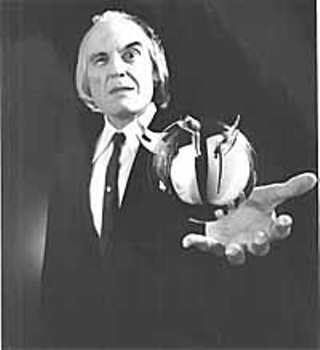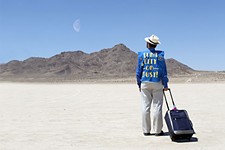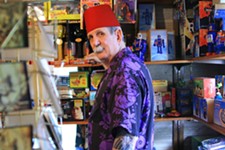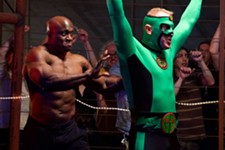Sphere of Influence
Don Coscarelli, Angus Scrimm, and Reggie Bannister on Phantasm-ania
By Marc Savlov, Fri., March 31, 2000

"Two dull brothers take on a flying object that punctures skulls, as well as a creepy cemetery worker whose ties are so thin he should be playing 'Louie, Louie' at a 1964 prom. Followed by sequel." That's Leonard Maltin's synopsis of Don Coscarelli's 1979 cult horror/sci-fi hybrid Phantasm, excerpted from my dog-eared copy of Maltin's Movie & Video Guide. I love that final sentence, presupposing (as it seems to) that the sequel just has to be godawful. In Maltin's eyes, of course, it is -- though 1988's Phantasm II was head and shoulders above the original in terms of budget, effects work, and overall slick feel. What my battered Maltin (circa 1995) fails to note is that there were two more sequels in the series, amounting to one of the strangest and most engaging genre franchises to grace the screen in decades.
Phantasm, once cast as a pre-Halloween horror snafu (although oddly loved as much for its readily apparent flaws as for its creepy virtues), has evolved into a genuine underground cult film phenomenon, with its own fan conventions, midnight screenings, and rabid Web sites, all while staying resolutely below the mainstream genre radar inhabited for most of the previous two decades by such films as Wes Craven's A Nightmare on Elm Street and the works of John Carpenter.
The original Phantasm is a truly bizarre mix of outlandish horror, cheapo gore, and psychological mindgames that purposefully blur the line between waking and dreaming. As the series' singular villain, the cadaverous Angus Scrimm (who, in a previous life as gentleman/scholar Lawrence Rory Guy, won a Grammy for his liner notes to an Erich Wolfgang Korngold LP) stalks through all four of the series' entries as the Tall Man, maintaining a grim and steely visage throughout. Unlike the villains of the chatty slashers that have overrun the past several genre booms, Scrimm's Tall Man has no use for wisecracks and witticisms -- he's content to snap necks and command a veritable army of evil dwarves and deadly, flying silver spheres that latch onto victim's foreheads and suck their (alleged) brains out. As a rule, the victims aren't the brightest lot.
Pitted against this otherwordly funeral director are Reggie Bannister's character Reggie, a shotgun and guitar-wielding mensch with a receding hairline and a turbo-charged libido (nearly as fast as the jet black HemiCuda he drives). Alongside Reg is his friend Mike (played in Phantasm II by James Le Gros, and in all the other outings by A. Michael Baldwin), who entered the fray after his brother Jody was killed by The Tall Man in the original film.
Make sense? Didn't think so. Part of the glorious fun of this ongoing series is that they bear the full weight of their own (un)reality. Call it existential-surrealist horror, and you're halfway there. And for all its flaws -- the omnipresent feeling of "What the hell is going on here?!" chief among them -- the series has survived and thrived like no other, taking body hits in the form of studio meddling (Universal backed the first sequel), minuscule budgets, and the occasional lapses in continuity.
Throughout it all, director Don Coscarelli, an auteur in the purest sense of the word, has maintained his own vision and a remarkable stable of talent through all four films. The outre world of Phantasm is not to everyone's taste, certainly, but for audiences craving a bit of weird in their cinematic mayhem diet, there's nothing better short of Alejandro Jodorowsky or early Luis Buñuel. It's that strange.
This weekend, the Alamo Drafthouse is hosting "Phantasm-ania," a three-day festival of the horror films that Coscarelli, Bannister, and Scrimm are coming to town to host. We spoke to all three of them by phone recently about the amazing success of their work together over the years and why on Earth it's been so successful in the first place ...
Austin Chronicle: Reggie, tell me what you thought when you first read the Phantasm script. Was it pretty much the same as what we see in the film today?
Reggie Bannister: I don't really recall seeing the script. To tell you the truth, I know that the script changed so many times during shooting that I'm not sure it would have really made any difference. I remember showing up on the set and discussing dialogue with Don and trying things out. It was very fly-by-the-seat-of-your-pants, and a lot of fun to boot.
Don was very much into on-the-spot improvisation. The thing of it was, Don's a very creative guy and he knows that the creative process carries on past what might be in the script. There's time when he might go, "Hey, I really like the way this is flowing," you know? He gets really precise with it. But then there's other times when he's like, "What do you guys think?" He's a real pleasure to work with.
AC: How was the shoot for the original film? I know there were a lot of budgetary considerations to tackle and so forth. How tough was it?
Bannister: It lasted for a long time. We shot that film over three-plus years. Michael Baldwin ["Mike"] actually grew up while we were filming. If you look at some scenes he's a little taller and we were really worried about him growing, you know, hair on his face over the course of the shoot.
Angus Scrimm: I thought the film and the shooting were kind of a mess. It went on for well over a year. It was obvious that there were terrific moments in it and I loved what I was given to do and what I was able to do with it. But the first test screening with an audience that Don had pulled out of a Saturday night movie line was kind of a disaster. The movie was much too long and so he took it back and edited it and made it into the film that it is today. And suddenly we had something that several studios were vying to pick up.
Coscarelli: It was a massive undertaking because, for starters, I kind of erred and wrote a script that was far too long and had a lot of character development in it that we shot but then had to jettison. Some of those scenes were in the recent MGM collector's DVD that came out. The actual experience of making the movie was very long and very difficult and very challenging. I always laugh because I listen to these interviews of actors on "real" Hollywood movies saying what an arduous shoot they've been on -- these guys don't know the meaning of the word arduous. Sometimes we'd work 20 hours straight, we'd have a rented camera that we had to get back, we had to scout our own locations, rig our own effects, and then shoot for two days on the weekends. And then do it all over again the next week. But it was a passion. We knew that there was something really cool just by watching the characters evolving in front of the camera.
AC: Where did the idea for the spheres come from? In all the history of horror films, that has to be one of the most original killing devices ever conceived.

Coscarelli: I had a dream in which I was being pursued by these tiny silver spheres, but in my dream they didn't really drill into you or anything, they just chased me down this long corridor. I always thought that'd be kind of a cool thing to throw in a scary horror film. At first it didn't seem like an obvious scare, but if you see the film, it works.
AC: The other shocker in Phantasm is, of course, Angus' portrayal of the Tall Man ...
Bannister: Oh, yeah. Angus is a consummate professional on set, right? Everything has to be just so for him. However, he's two people on the set: He's the Tall Man, and then he's ... your friend. And never the twain shall meet. When he's the Tall Man, he can be pretty frightening to bump into on the set because he's got his game face on, and he's into it. But on the other side, Angus is very much a gentleman and enjoys gourmet cooking and so on. He's a very civilized human being.
Coscarelli: He was the first adult actor that I'd worked with [on Jim the World's Greatest, 1976], and even when he's playing a more benign character he has moments where he can be very intimidating. I'll be honest: He used to intimidate me. I always thought he'd make a great villain, and so when I started cobbling together the Phantasm idea I immediately thought of him.
AC: What was the initial reaction to the film? I was too young to go see it in theatres, but I remember having some seriously uneasy dreams after all the ads ran on TV with Angus scowling out at me.
Bannister: None of us were ready for the reaction. We were just digging on the fact that it was released at all and that it was all over town, because we all had to stay alive and do, you know, our day jobs, such as they were. At the time that it was released, I was working at a flower job delivering flowers for the day job and working in clubs at night. The flower shop was actually on the property of a cemetery mausoleum that we had used in the film. I remember being at a gas station just down the road from there, filling my flower shop van, and seeing, across the road, a drive-in theatre which, coincidentally enough, was playing Phantasm. So there I was, pumping gas in my van, watching myself on the drive-in as I'm getting ready to make my flower run. It was like, wow, really a dichotomy of consciousness. Very surreal.
At the time though, I didn't really have a sense of how large the film would become.
Coscarelli: We were just hoping to get the movie finished and get a domestic distributor to put it out in theatres. That was really all we hoped for. And to think that two decades later I'm still making Phantasm movies ... I just never would have believed it.
AC: Phantasm II [1988] has always been my personal favorite. Was that shoot easier than the original since you had Universal's money on hand, or did they tend to get in your way?
Bannister: Sure, we had more money, and that was nice because we had some effects going on that we didn't have to go to the five-and-dime to create. That's where we hooked up with Bob Kurtzman and Greg Nicotero of KNB Effects (although they weren't yet called that because Howard Breuger hadn't yet come along). Not that you can have a great picture because you have many effects, mind you, but it was nice to see the Tall Man melt, and to see his eyes pop out, you know? And it was cool to see the priest lose his ear to a sphere and then to see him strung up by his own ... well, there was just so much good shit in that one.
Coscarelli: I'd been under pressure to do a sequel for a while and I just didn't see it until one day I was sitting around thinking, well, what if the movie started the second the first one ended? Once I got that idea, which is really pretty obvious, the script just came out. Luckily for us, the only man in Hollywood who knew anything about Phantasm happened to be this guy Tom Pollack, who was at Universal and was really interested in getting a horror franchise. And they ended up spending the lowest amount of money that Universal has ever spent on a movie in that decade but the largest amount of money that we've ever received, which was about three million, so it all worked out and we were able to go to town on that.
Bannister: During the first one, a lot of the creative process was happening while we were filming -- Don would change things on the set all the time and it was almost being written as we filmed it, which was nice. During the second film, we had to stick more with the script and you could really tell there was more pressure being brought to bear.
AC: Did you have any idea the cult following would be this huge? And do you have any theories why that may be?
Bannister: It's a real interesting level that we've settled into here. My real take on it is that we have not seen the full extent of where this Phantasm mania is going to go because there are obviously tons of people who have never seen the picture. The film -- and I know it sounds funny to say this -- can really be a life-changing experience, especially for younger people. They see that sphere for the first time and they're like, "What the hell is that thing?!" And it just kind of sticks with them. Yes, it is a ravenous, underground group of film fans. I think that after I croak you'll be watching it on TV and it'll be right up there with Frankenstein, Dracula, and all the others. The character of Tall Man will be part of that whole crowd.
Scrimm: I think it touches something atavistic inside. Because it does deal in both an upfront and subliminal way with death that it reaches deep inside the viewer, some certain viewers. We have a very large following among people in the funeral business, for example. We've in fact inspired a number of them, including one person who will be coming to Austin ex-officio, Kristen Deem, who was a little girl in New Jersey who saw it when she was about 12 years old, grew up, went to Stanford, and then went, of all things, into mortuary science school. And she has since worked on three of the Phantasm films in various capacities as unit publicist, gopher, and so on.
A number of the fans are drawn to death, as I think most of us are, to a degree, and think the films touch that chord in a number of the young people who are a bit more cerebral.
Coscarelli: You know, my first response to that is I don't have a clue, but I do think about it a lot, and I've come to a couple of conclusions. Number one, it's a predominantly male story, and a young teen audience really responds to it. If you see it in that period in your life it has an impact and it stays with you. Number two, the characters, starting with Angus, have an effect on people, especially him. They love to be scared by him (and they're definitely afraid of his character), yet they have a fondness for him. It's a very strange contradiction. I don't understand it completely, but, you know, as a director, I'm just glad it's there. ![]()
"Phantasm-ania" runs at the Alamo Drafthouse, 409 Colorado, Mar 30-Apr 1, midnight. Reggie Bannister, Angus Scrimm, and Don Coscarelli will be in attendance. Three-day festival passes, $35, available in advance at the Alamo. Single-night tickets, $13, available at the door. 867-1839 or http://www.drafthouse.com for more information.










